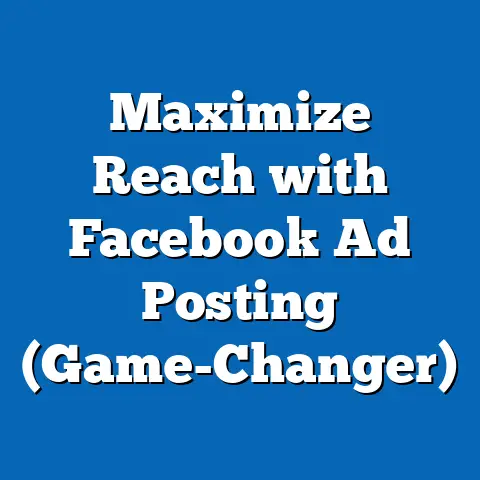Seamless Admin Addition on Facebook Pages (Expert Strategies)
In today’s visually-driven digital landscape, a Facebook Page isn’t just a profile; it’s a storefront, a community hub, and often, the first impression a potential customer has of your brand. I’ve seen firsthand how a well-designed Facebook Page, bursting with bold and eye-catching visuals, can significantly boost user engagement and brand visibility. Think of it like this: your Facebook Page is the digital equivalent of walking into a beautifully designed store – it invites you in, makes you want to linger, and ultimately, encourages you to explore further.
But managing such a dynamic platform requires a team, and that’s where the seamless addition of admins becomes crucial. The key is to onboard these individuals in a way that doesn’t disrupt the visual and operational integrity of your page. It’s about ensuring a smooth transition, preserving brand consistency, and empowering your team to contribute effectively. In this guide, I’ll share expert strategies for adding admins to your Facebook Page without sacrificing its design appeal or operational efficiency. I want to equip you with the knowledge and tools to build a strong, collaborative team that elevates your brand’s presence on Facebook.
Understanding the Role of Admins on Facebook Pages
Before diving into the “how,” let’s understand the “why.” What exactly is an admin on a Facebook Page, and why is it so crucial to get the roles right?
An admin on a Facebook Page is essentially someone granted specific permissions to manage various aspects of the page. Facebook offers several different roles, each with its own set of capabilities:
- Admin: The highest level of access. Admins can manage all aspects of the Page, including assigning roles, editing the Page, creating and deleting posts, running ads, viewing insights, and responding to comments and messages.
- Editor: Editors can perform many of the same functions as admins, except they cannot assign roles or delete the Page. They can create and edit posts, run ads, view insights, and respond to comments and messages.
- Moderator: Moderators focus on managing the community. They can respond to and delete comments, send messages as the Page, see which admin or editor created a post or comment, and ban people from the Page.
- Advertiser: Advertisers can create ads, view insights, and see who created a post or comment.
- Analyst: Analysts can view insights and see who created a post or comment.
Why does this matter? Because having the right people in the right roles is paramount to maintaining a cohesive brand image and ensuring efficient operations. Imagine giving someone with no design experience the power to drastically alter your Page’s visuals. Disaster, right?
I recall working with a client, a local bakery, who initially gave everyone on their staff admin access to their Facebook Page. The result was a chaotic mix of blurry photos, inconsistent branding, and poorly worded posts. It wasn’t until we restructured the roles, assigning admin rights only to the marketing manager and editor rights to a designated social media coordinator, that their Page started to reflect the quality and care they put into their baked goods.
Think of successful brands that leverage a team of admins effectively. Take Nike, for example. Their Facebook Page is a masterclass in visual storytelling, with high-quality imagery, engaging videos, and consistent branding. This doesn’t happen by accident. It requires a dedicated team of admins, each with specialized skills, working in harmony to curate a compelling online experience. They likely have roles dedicated to content creation, community management, advertising, and analytics, ensuring that every aspect of their Facebook Page is optimized for success.
Key Takeaway: Understand the different admin roles and assign them strategically based on individual skills and responsibilities. This is the foundation for a well-managed and visually appealing Facebook Page.
Steps to Seamlessly Add Admins to Your Facebook Page
Okay, now let’s get practical. Adding admins to your Facebook Page is a straightforward process, but it’s crucial to follow the steps carefully to avoid any hiccups.
Here’s a step-by-step guide:
- Access Your Facebook Page: Log in to your Facebook account and navigate to the Page you want to manage.
- Go to Settings: Click on “Settings” at the top right of your Page.
- Navigate to Page Roles: In the left-hand menu, click on “Page Roles.”
- Assign a New Page Role: In the “Assign a new Page role” section, start typing the name or email address of the person you want to add as an admin. Facebook will search for matching profiles.
- Select the Role: Choose the appropriate role from the dropdown menu (Admin, Editor, Moderator, etc.).
- Add: Click “Add.”
- Confirmation: The person you’ve added will receive an invitation to accept the role. Once they accept, they’ll have the assigned permissions.
Important Considerations:
- Friend or Not? You can add someone as an admin even if you’re not friends with them on Facebook, as long as you know their email address.
- Double-Check: Always double-check the person’s name and profile picture before assigning a role to ensure you’re adding the correct individual.
- Clear Communication: Before adding someone as an admin, have a conversation with them about their responsibilities and the brand’s visual and operational guidelines.
I’ve learned the hard way the importance of clear communication. I once added someone as an editor to a client’s Page without properly explaining their role or the brand’s visual identity. Within a week, the Page was filled with irrelevant content and mismatched graphics. Thankfully, we were able to rectify the situation quickly, but it served as a valuable lesson in the importance of setting expectations and providing thorough onboarding.
Key Takeaway: Adding admins is simple, but ensuring they understand their role and the brand’s guidelines is essential for maintaining consistency and avoiding potential mishaps.
Strategies for Effective Collaboration Among Page Admins
Adding admins is only half the battle. The real challenge lies in fostering effective collaboration and communication among your team. A well-coordinated team can work wonders, but a disjointed group can quickly lead to chaos and inconsistency.
Here are some strategies I’ve found invaluable for promoting collaboration:
- Establish Clear Communication Channels: Utilize tools like Slack, Microsoft Teams, or even a dedicated Facebook Messenger group to facilitate quick and easy communication. This allows admins to share updates, ask questions, and coordinate tasks in real-time.
- Implement Project Management Tools: Platforms like Trello, Asana, or Monday.com are excellent for organizing tasks, assigning responsibilities, and tracking progress. These tools provide a central hub for all Page-related activities, ensuring that everyone is on the same page.
- Regular Meetings and Check-Ins: Schedule regular meetings, whether in-person or virtual, to discuss strategy, review performance, and address any challenges. These meetings provide an opportunity for admins to share ideas, provide feedback, and ensure that everyone is aligned with the overall goals.
- Create a Shared Content Calendar: A content calendar is a visual representation of your planned content schedule. It helps admins coordinate their efforts, avoid overlap, and ensure a consistent flow of engaging content. Tools like Google Calendar or dedicated social media scheduling platforms can be used for this purpose.
- Develop a Style Guide: A style guide outlines your brand’s visual identity, including logo usage, color palettes, typography, and imagery guidelines. This ensures that all content created by your admins adheres to your brand’s aesthetic standards.
I once worked with a team that struggled with communication and coordination. They were using a combination of email, text messages, and sporadic phone calls to manage their Facebook Page. The result was a confusing and inefficient process, with missed deadlines, duplicated efforts, and inconsistent branding. By implementing a project management tool and establishing a clear communication channel, we were able to streamline their workflow, improve collaboration, and significantly enhance their Page’s performance.
Key Takeaway: Effective collaboration requires clear communication channels, project management tools, regular meetings, a shared content calendar, and a comprehensive style guide. These elements work together to ensure that your admin team is aligned, efficient, and productive.
Maintaining Brand Aesthetics Post Admin Addition
One of the biggest concerns when adding new admins is the potential impact on your brand’s aesthetics. It’s crucial to ensure that the addition of new team members doesn’t compromise the visual consistency and appeal of your Facebook Page.
Here are some strategies for maintaining brand aesthetics:
Key Takeaway: Maintaining brand aesthetics requires a comprehensive style guide, pre-designed templates, thorough training, a robust review process, and potentially, brand management software. These elements work together to ensure that all content created by your admins aligns with your brand’s visual identity.
Case Studies of Successful Admin Addition
Let’s look at some real-world examples of brands that have successfully added admins to their Facebook Pages without sacrificing their visual appeal or operational efficiency.
Case Study 1: Sephora
Sephora’s Facebook Page is a prime example of effective team management. Their content is consistently high-quality, visually appealing, and aligned with their brand identity. They likely have a team of admins specializing in different areas, such as product photography, graphic design, copywriting, and community management. This allows them to create a diverse range of engaging content while maintaining a cohesive brand aesthetic.
Key Learning: Sephora demonstrates the power of specialization. By assigning roles based on individual skills and expertise, they’re able to create a high-performing team that consistently delivers exceptional content.
Case Study 2: National Geographic
National Geographic’s Facebook Page is renowned for its stunning photography and compelling storytelling. They likely have a team of admins who are passionate about wildlife, conservation, and exploration. These admins are responsible for curating and sharing breathtaking images and videos, as well as engaging with their audience in a meaningful way.
Key Learning: National Geographic highlights the importance of passion and expertise. By entrusting their Facebook Page to individuals who are deeply knowledgeable about their subject matter, they’re able to create authentic and engaging content that resonates with their audience.
Case Study 3: Airbnb
Airbnb’s Facebook Page is a masterclass in community building. They regularly feature photos and stories from their hosts and guests, creating a sense of connection and belonging. They likely have a team of admins who are dedicated to fostering a positive and supportive community.
Key Learning: Airbnb demonstrates the power of community engagement. By prioritizing their hosts and guests, they’ve created a thriving online community that strengthens their brand and drives customer loyalty.
Key Takeaway: These case studies highlight the importance of specialization, passion, and community engagement in successful Facebook Page management. By learning from these examples, you can build a team that elevates your brand and achieves your marketing goals.
Conclusion: The Future of Facebook Page Management
As Facebook continues to evolve, the role of admins will become increasingly important. The platform is constantly introducing new features and functionalities, requiring admins to stay up-to-date on the latest trends and best practices. In the future, I believe we’ll see a greater emphasis on data-driven decision-making, personalized content, and interactive experiences. Admins will need to be proficient in analytics, content creation, and community management to thrive in this dynamic environment.
With careful planning, the addition of new admins can enhance your brand’s presence and engagement on Facebook, leading to greater success in social media marketing. Embrace bold designs and seamless admin integration as vital components of your social media strategy. It’s about building a team that is not only skilled and knowledgeable but also passionate about your brand and committed to delivering exceptional results.
Call to Action
Now, it’s your turn. Take a moment to evaluate your current Facebook Page management strategy. Is your admin team effectively aligned with your brand vision? Are you leveraging the right tools and processes to foster collaboration and maintain brand consistency? If not, take steps towards seamless integration of new admins to drive success and engagement on your Facebook Pages.
Start by reviewing your admin roles and responsibilities. Are they clearly defined and aligned with individual skills and expertise? Next, assess your communication channels and project management tools. Are they facilitating efficient collaboration and coordination? Finally, evaluate your brand style guide and training materials. Are they comprehensive and accessible to all admins?
By taking these steps, you can create a Facebook Page management team that is not only effective but also a valuable asset to your brand. Remember, a well-managed Facebook Page is a powerful tool for driving engagement, building brand awareness, and achieving your marketing goals. So, embrace the challenge, invest in your team, and watch your Facebook Page thrive.






